Fire alarm bells can be — and often are — mounted outside using weather-proof components
Can you mount an alarm bell outside? Sure. Some fire alarm and sprinkler systems may even require it. But electrical devices exposed to wind, rain, dirt, dust, and damage can become hazards. It’s important to install them properly, and protect them with devices like outdoor wire guards or bell boxes.
In this article, we explain how fire alarm and sprinkler systems use alarm bells, discuss how you can mount alarm bells outside, and shed some light on the available weatherproofing options.
If you’ve come here looking for bells, a way to protect them, or related equipment, feel free to check out:
- 10″, 120-volt fire bells—the most common choice when installing a water flow alarm that doesn’t connect to a fire alarm control panel
- 10″, 24-volt fire bells, which have the right listing and voltage for integration with many fire alarm systems
- Water motor gongs that sound a sprinkler or standpipe alarm without electricity
- Back boxes and wire guards to defend outdoor bells against weather, nesting birds, and impact
- Fire department connections and FDC accessories
Many fire sprinkler systems include devices designed to sound an audible alarm
Many fire sprinkler and alarm systems feature devices that attach to sprinkler system piping to trigger a bell, gong, or another notification device when water flows. These devices, called waterflow alarms, are designed to sense running water when fire sprinkler heads activate. The National Fire Protection Association (NFPA), an organization that develops model fire codes and standards for use by state and local governments, provides details for their design — either electrically or mechanically operated — in NFPA 13: Standard for the Installation of Sprinkler Systems.
From the 2022 edition of NFPA 13
7.7.1 Mechanical waterflow alarm devices shall be listed for the service and so constructed and installed that any flow of water from a sprinkler system equal to or greater than that from a single automatic sprinkler of the smallest K-factor installed on the system will result in an audible alarm on the premises within 5 minutes after such flow begins and until such flow stops.
7.7.2 Electrical waterflow alarm devices shall be listed for the service and so constructed and installed that any flow of water from a sprinkler system equal to or greater than that from a single automatic sprinkler of the smallest K-factor installed on the system will result in an audible alarm on the premises within 100 seconds after such flow begins and until such flow stops.
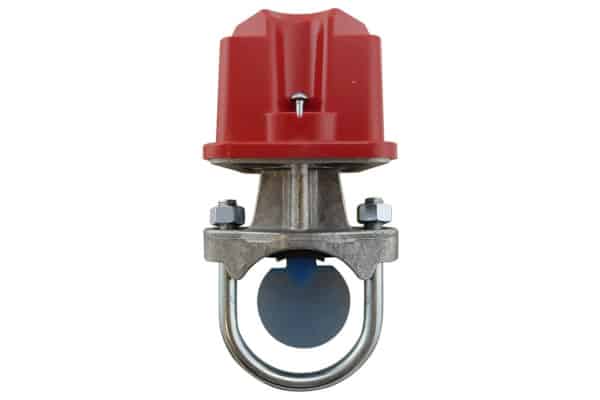
NFPA 13 requires local waterflow alarms on fire sprinkler systems with more than 20 sprinkler heads.
From the 2022 edition of NFPA 13
16.11.2* Sprinkler Alarms/Waterflow Alarms.
16.11.2.1 Local Waterflow Alarms. A local waterflow alarm shall be provided on every sprinkler system having more than 20 sprinklers
While the standard strongly suggests that these sprinkler waterflow devices also activate fire alarm control panels or send a signal to the fire department (see section A.16.11.2), local waterflow alarms are designed to trigger audible or visual alarms meant to be seen by people stationed or passing nearby.
Audible alarms for fire sprinkler systems are often located outdoors but require protection from the elements
Fire alarm bells connected to waterflow detectors can be mounted outside. In fact, many fire department connections (FDCs)—inlets firefighters use to supply water to a building’s fire protection system—feature outdoor alarms that perform a few functions:
- Letting passersby know that the sprinkler system has activated
- Encouraging people to contact emergency services
- Letting firefighters know that the sprinkler system is active
- Directing firefighters to the FDC
In fire sprinkler systems, audible alarms, including fire alarm bells, are often mounted outside. NFPA 13 explicitly discusses outdoor installations of alarm bells connected to fire sprinkler systems.
From the 2022 edition of NFPA 13
16.11 System Attachments.
16.11.1 Attachments — General.
16.11.1.1* An alarm unit shall include a listed mechanical alarm, horn, or siren or a listed electric gong, bell, speaker, horn, or siren.
16.11.1.2* Exterior water motor-operated or electrically operated bells shall be weatherproofed and guarded.
A.16.11.1.1 Audible alarms are normally located on the outside of the building. Listed electric gongs, bells, horns, or sirens inside the building, or a combination of such used inside and outside, are sometimes advisable.
Outside alarms might not be necessary where the sprinkler system is used as part of a central station, auxiliary, remote station, or proprietary signaling fire alarm system, utilizing listed audible inside alarm devices.
A.16.11.1.2 All alarm apparatus should be so located and installed that all parts are accessible for inspection, removal, and repair, and such apparatus should be substantially supported.
A water motor-operated gong bell mechanism should be protected from weather-related elements such as rain, snow, or ice. To the extent practicable, it should also be protected from other influencing factors such as birds or other small animals that might attempt to nest in such a device.
The specific requirements for your fire sprinkler system will vary. Local fire authorities and your city, state, or county’s fire code may provide more specific guidelines for placement.
But in another section (A.16.11.2), the NFPA notes that when these bells are mounted outdoors, they should also feature easy-to-see signage with the words: SPRINKLER FIRE ALARM — WHEN BELL RINGS CALL FIRE DEPARTMENT OR POLICE. And remember NFPA 13 requires that these devices be weatherproofed and guarded when installed outside (16.11.1.2).
Outdoor wire guards and bell boxes, along with bell signs, are available at QRFS.
Bells used in fire sprinkler or alarm systems (or for other reasons) may safely be installed outside so long as they’re designed for outdoor use
We’ve had a number of customers who want to use our bells for reasons unrelated to fire protection. One customer wired an alarm bell to his business doorbell so staff in his noisy workshop would be able to hear when a visitor arrived. Another customer, who worried about burglars, wired one to a motion sensor in front of his garage and mounted his alarm bell outside a few hundred yards from his house.
While the use cases vary, the ability to safely mount the alarm bell outside is key. Weather-resistant fire alarm bell back boxes replace standard outlet boxes with a dust-, dirt-, and debris-resistant closure. A well-designed back box provides an air- and water-tight seal that allows fire alarm bells to endure the elements without running the risk of shorting electrical components. These boxes feature a pre-cut opening through the bottom for conduit and wires.
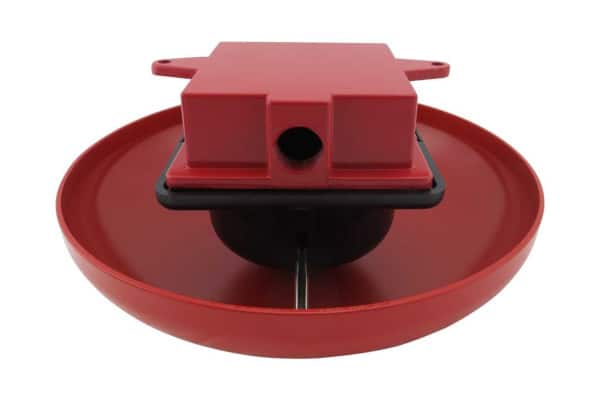
In addition, outdoor wire guards can minimize the damage from impact or nesting birds. But it’s important that the bell itself be suitable for outdoor use. Corrosion-resistant finishes can prevent the bell from weathering prematurely.
Install weatherproof fire alarm bells and back boxes outside with QRFS
QRFS carries 120-volt and 24-volt alarm bells in 6-inch, 8-inch, and 10-inch sizes for fire protection applications. These UL-listed bells feature a corrosion and weather resistant enamel coating in a fire-engine-red finish.
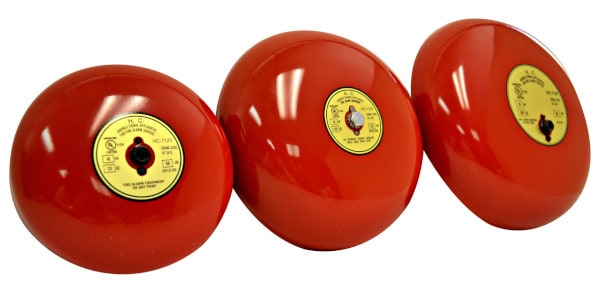
QRFS also carries air-tight fire alarm bell back boxes that let you install your alarm bell outside without running the risk of water, weather, or dirt-caused short. These boxes fit 6-inch, 8-inch, and 10-inch alarm bells installed to standard 2-gang openings.
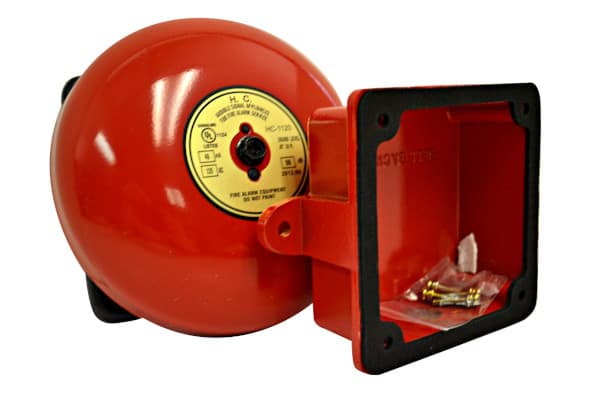
Click here to shop our selection of fire alarm bells and accessories.
Need more guidance on installing a fire alarm bell outside? Call us at +1 (888) 361-6662, or email us at support@qrfs.com.
Like what you’ve read? Check us out at Facebook.com/QuickResponseFireSupply or on Twitter @QuickResponseFS.


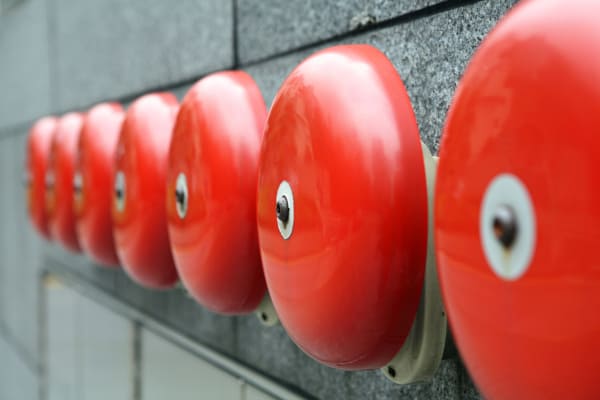

Hi sir
Could you please quote me 02x fire alarm bells.
Regards
David mwale
David, thanks for reaching out. All our fire alarm bells are available for purchase online! Our bells are some of the loudest bells on the market and perfect for security systems, schoolyards, and fire sprinkler systems. View our full selection of fire alarm bells, bell backboxes, and wire guards. If you need assistance making a selection, you can reach us at support@qrfs.com or 888-361-6662.
Hey, this is a nice article about the fire alarms and this article explains really good points how the alarm use bells. Thanks a lot for bringing this topic into light, I really appreciate your effort of explaining everything so particularly.
Is the fire bell needs to be on emergency circuit? I can’t find in the code for this requirement.
If it does, the requirement and conditions would be within NFPA 72 (not NFPA 13). You can try our Ask a Fire Pro service; a pro will provide a well-researched answer after you provide specific information about your system and scenario. Thanks for reading!